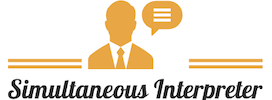Interpretation is the oral translation of an idea, thought or speech. The interpreters convert the words expressed in the source language into specific languages. The most requested types of interpretation services are simultaneous interpreting and consecutive interpreting.

As the term implies, simultaneous interpreting begins almost at the same time that a speaker starts conveying the message to the audience in a conference or meeting where multilingual participants are present. Typically, the number of interpreters in a large conference depends on the number of unique languages that participants speak.
Intricacies of Simultaneous Interpretation
Any type of interpretation work is demanding, but simultaneous interpretation ranks on top of the list. Aside from fluency in a language pair, the simultaneous interpreter should be a quick thinker, have sharp hearing, subject matter expertise and extensive vocabulary in the source and target languages. Knowledge of the nuances of the target culture is likewise vital, to help them adapt their communication style to the recipients.
Simultaneous interpreting needs a soundproof booth for the interpreters. The interpreter listens to the speaker through a headset and speaks to the target audience through the headphones’ speaker.
The task demands so much from the interpreter, which is why they usually work in tandem with another interpreter. Moreover, they do not use any reference book or dictionary while doing their job. They listen to the speaker and start interpreting with only a few seconds’ delay.
Unlike translation work where there is more time to prepare the translation, along with using CAT tools and reference materials, the interpreter relies on their experience and skills while on the job. Simultaneous interpretation is always in real-time. The interpreter listens to what the speaker is saying, paraphrases it while retaining the original meaning of the message, and delivers it in the intended language.
Differences Between Simultaneous and Consecutive Interpretation
Two of the most used interpretation services are simultaneous interpretation and consecutive interpretation. Both need high levels of fluency in the language pair and subject matter expertise, the two types have differences, as well.
Simultaneous Interpretation
It demands deep concentration from the interpreter. The delivery of the message in another language is just a few seconds after the speaker starts speaking. The interpreter carefully listens, converts the words, and delivers them immediately in the target language. A simultaneous interpreter should have excellent speaking and improvisation skills.
Due to the demanding nature of simultaneous interpreting, they often work in pairs, so one interpreter can take a mental and vocal rest.
Simultaneous interpreting is likewise known as conference interpreting. Big international meetings and conferences at the United Nations often use simultaneous interpretation.
Consecutive Interpretation
The speaker delivers a sentence before the interpreter translates it into the target language. The time delay is noticeable, and the service is applicable for small meetings where time is not a constraint. In consecutive interpretation, the listener usually responds and the interpreter translates the response into the other language. You can use consecutive interpreting for medical consultations, school conferences, and interviews.
Why Simultaneous Interpretation Is Important
Interpretation makes oral communication easier. The process helps conference delegates to communicate in his language and easily follow what the different speakers are saying immediately and in real-time. Here are some reasons why simultaneous interpretation service is important.
- Communication becomes efficient. In a conference, all the delegates can deliver their message in their language and listen to other participants’ messages in the language they speak. Simultaneous interpretation bridges the communication gap.
- The messages remain intact as the interpretation happens in real-time. While interpreting services do not translate what is being said word for word, the interpreter paraphrases the message, which is why interpreters should be subject matter experts.
- Mounting a big conference is difficult and needs a lot of work. Hiring an excellent team of simultaneous interpreters will tie up all the loose ends because the team will see to it that correct communication among all the participants becomes possible.
- Simultaneous interpretation is a time-saver. Instead of translating speeches in different languages, which can take time, simultaneous interpretation can deliver the messages in each language that help participants understand the thoughts and ideas immediately.
- Simultaneous interpretation delivers messages accurately. Simultaneous interpreters have years of experience behind them. They are subject matter experts, so they have the proper background knowledge about the topic or theme of the conference. The interpreter relays the message in the target language almost at the same time, thus, the translation of the message is better and more accurate.
Requirements of Simultaneous Conference Interpreting
When hosting a large conference or multinational meeting that requires simultaneous interpreting services, the conference set up should include the requirements of the interpreting teams in the venue layout. It is better to have a checklist of all the requirements to make sure that the interpreters’ booths are in the right place.
1.Technical equipment
The interpreting agency can provide their booths and technical audio equipment, or they can recommend the services of a group they usually work with during conferences. Either way, the agency has to make sure that the interpretation teams’ technical requirements are met.
2.Soundproof booths
Check the floor plan to see to it that interpreters’ booths are in the right place. The interpreters should be able to see the speakers.
See to it that there are enough booths for all the interpreting teams. Each outgoing language should have a soundproof booth.
Each booth should be able to accommodate two to three interpreters. The interpreters must be able to stand or sit comfortably while interpreting.
Each booth should have a table that will serve as the work area of the interpreters. The table should be deep enough to hold the equipment, reference books, conference guides, papers and pens, water bottles and other items they need.
3.Visibility
The booths should have clear windows on the sides and in front, with no vertical support in front that can hamper the view of the interpreters. The interpreting teams should be able to see one another. The booths should not be positioned in front of windows to prevent glare.
The distance of the booth to the stage or podium should be short so that the interpreters can clearly see the monitors or projection screen to read the presentations. If the distance is a problem, each booth should have TV monitors.
The booths should be higher by at least one meter to enable the interpreters to see across the entire conference venue.
For Your Professional Simultaneous Interpreting Services, Contact Us!
When you need simultaneous interpreting services, you only need to call Interpreting Services. We are a professional language services provider with a worldwide network of native-speaking interpreters and translators. They are all highly skilled and experts in different subject matters, to see to it that we provide accurate interpretation and translation services.


















